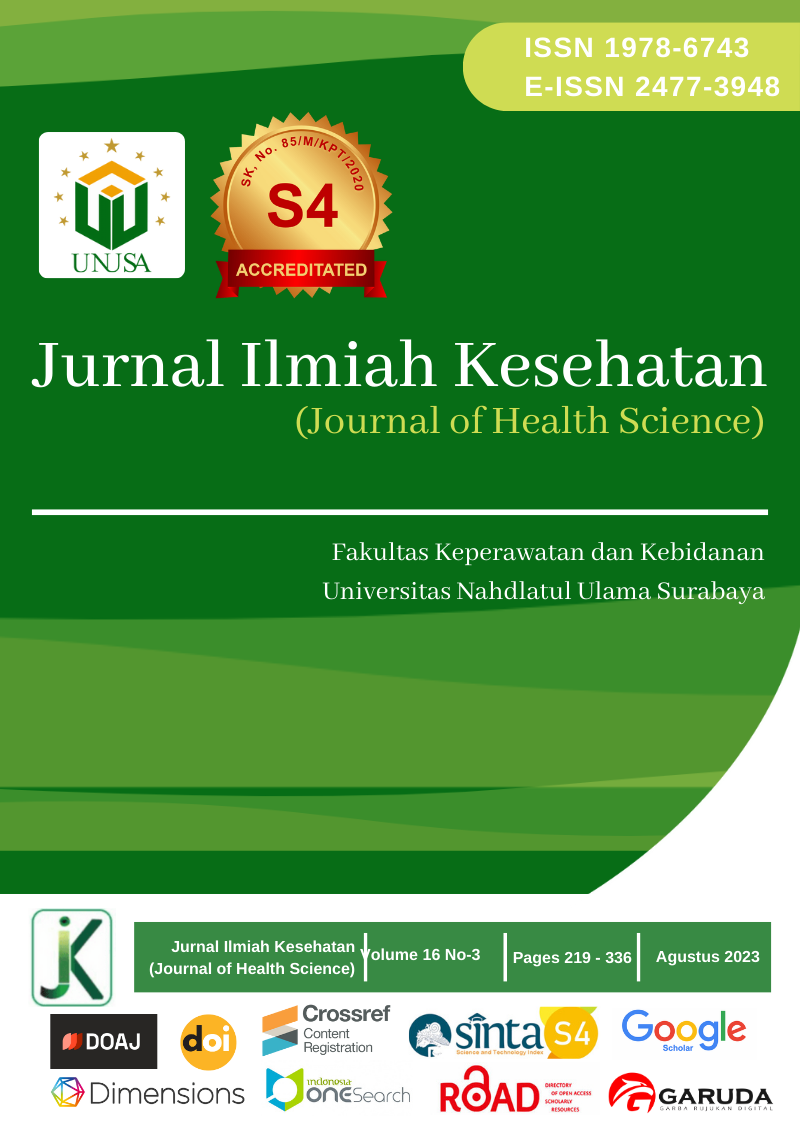The Correlation between Knowledge and Compliance with Personal Protective Equipment (PPE) Use in Construction Workers at EMC Alam Sutera Hospital, South Tangerang City
Main Article Content
Abstract
Construction work has a high-risk workplace. Construction workers are often faced with difficult and dangerous working situations. One of the efforts to protect workers in Occupational Safety and Health (OSH) is by supplying Personal Protective Equipment (PPE). This study analyzes the correlation between knowledge and compliance with personal protective equipment (PPE) used in construction workers. This paper correlated quantitative research with a cross-sectional approach. The study population was all construction workers at EMC Alam Sutera Hospital, South Tangerang, totaling 70 people. There were 70 respondents with a total sampling technique. The instruments were PPE compliance observation sheets and PPE knowledge questionnaires. Data analysis was univariate and bivariate analysis. Results showed that most respondents were 40 or older (60%). In addition, half of them had secondary and tertiary education (54.3%). Most also had good knowledge about PPE (65.7%). Of the 46 construction workers with good PPE knowledge, 42 complied with PPE use (91.3), and only four were not compliant (8.7%). Meanwhile, of the 24 construction workers with poor knowledge of PPE, 11 were not compliant with PPE use (45.8%), and 13 were compliant (54.3%). The statistical test results obtained were p=0.001. Thus, there was a significant correlation between knowledge and compliance with PPE use in respondents. In conclusion, knowledge correlates compliance with PPE uses among construction workers in EMC Alam Sutera Hospital, South Tangerang City. The hospital should provide recommendations to construction companies at EMC Alam Sutera Hospital, South Tangerang City, regarding using full PPE for construction workers.
Downloads
Article Details
Copyright (c) 2023 Melda Siahaan, Imas Sartika, Rangga saputra, Bernardo Oliber A. Arde

This work is licensed under a Creative Commons Attribution-ShareAlike 4.0 International License.
References
Ammad, S. et al. (2021) ‘Personal protective equipment (PPE) usage in construction projects: A scientometric approach’, Journal of Building Engineering, 35, p. 102086. DOI: https://doi.org/10.1016/j.jobe.2020.102086
Astiningsih, H., Kurniawan, B. and Suroto, S. (2018) ‘Hubungan Penerapan Program K3 Terhadap Kepatuhan Penggunaan APD Pada Pekerja Konstruksi Di Pembangunan Gedung Parkir Bandara Ahmad Yani Semarang’, Jurnal Kesehatan Masyarakat; Vol 6, No 4 (2018): JULIDO - 10.14710/jkm.v6i4.21431 [Preprint].
BPJS Ketenagakerjaan (2021) Claim Data for Work Accident Cases in 2020, BPJS Ketenagakerjaan.
Cahyani, F.T. (2020) ‘Pengaruh Pengetahuan dan Ketersediaan APD Terhadap Kepatuhan Pemakaian APD Pekerja PT PLN’, Majalah Kesehatan Masyarakat Aceh (MaKMA), 3(1), pp. 21–30. Available at: https://doi.org/10.32672/makma.v3i1.1491. DOI: https://doi.org/10.32672/makma.v3i1.1491
Diana, N. (2016) Health and Occupational Safety: Use of Personal Protective Equipment for Workers. Second. Semarang: Diponegoro University Publishing Agency.
Disnakertrans Provinsi Banten (2019) Occupational Safety and health Administration (OSHA) Banten Province in 2018.
Hakim, A.R. and Febriyanto, K. (2020) ‘Hubungan Pengetahuan Dengan Kepatuhan Penggunaan APD Pada Pekerja Di PT. Galangan Anugrah Wijaya Berjaya Samarinda’, Borneo Studies and Research, 2(1), pp. 446–452.
Hurlock, E. and B. (2017) Developmental Psychology An Approach Across the Life Span. 5th edn. Jakarta: Erlangga.
ILO (2018) Indonesian Labor Law: Major Labor Laws of Indonesia. Jakarta: International Labor Office.
Kemenakertrans RI (2010) Minister of Labor Regulation No. 08/MEN/VII/2010 on Personal Protective Equipment. Ministry of Labor of the Republic of Indonesia. Ministry of Labor of the Republic of Indonesia.
Mariana, S., Miswan and Andri, M. (2018) ‘Faktor-Faktor yang Berhubungan dengan Penggunaan Alat Pelindung Diri pada Perawat di RSUD Mokopido Kabupaten Tolitoli’, Jurnal Kolabaoratif Sains, 1(1), pp. 888–897.
Notoatmodjo, S. (2018a) Metodologi penelitian kesehatan. Jakarta: PT Rineka Cipta.
Notoatmodjo, S. (2018b) Pendidikan dan perilaku kesehatan. Jakarta: Rineka Cipta.
Nursalam (2011) Proses dan Dokumentasi Keperawatan : Konsep dan Praktik. Jakarta: Salemba Medika.
Potter, P. and Perry, A. (2015) ‘Nursing Fundamental Textbooks: Concepts, Processes & Practices (Vol. I)’, Jakarta: EGC [Preprint].
Rahmawati, E., Romdhona, N. and Fauziah, M. (2022) ‘Environmental Occupational Health and Safety Journal Faktor-Faktor Yang Berhubungan Dengan Kepatuhan Penggunaan Alat Pelindung Diri (APD) Pada Pekerja Konstruksi Di PT. Abadi Prima Intikarya Proyek The Canary Apartment Kota Tangerang Selatan Tahun 2022’, Environmental Occupational Health and Safety Journal •, 3(1), p. 75. DOI: https://doi.org/10.24853/eohjs.3.1.75-88
Saliha, J., Joseph, W.B.S. and Kalesaran, A.F.C. (2018) ‘Hubungan antara Pengetahuan dan Sikap dengan Kepatuhan Penggunaan Alat Pelindung Diri pada Pekerja PT. Hutama Karya Proyek Pembangunan Jalan Tol Manado-Bitung Tahun 2018’, KESMAS: Jurnal Kesehatan Masyarakat Universitas Sam Ratulangi, 7(5).
Syekura, A. and Febriyanto, K. (2021) ‘Hubungan Tingkat Pendidikan Dengan Kepatuhan Penggunaan APD PAda Pekerja Di Galangan Kapal Samarinda’, Borneo Student Research, 2(3), pp. 2002–2008.
Tarwaka (2017) Occupational Safety and Health: Management and Implementation of OSH in the Workplace. Surakarta: Harapan Press.
Tri Cahyani, F. and Widati, S. (2021) ‘The influence of behavior intention, personal autonomy, accessibility of information, and social support on the compliance of the use of ppe at PT. PLN’. DOI: https://doi.org/10.20473/ijph.v16i1.2021.112-123
Vadlin, R. (2019) ‘Factors Associated with Compliance with the Use of Personal Protective Equipment (PPE) in Harvesting Workers at Bagerpang Estate’.





